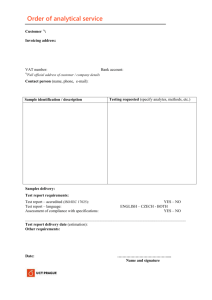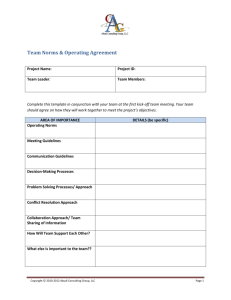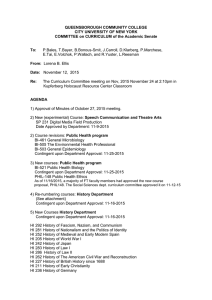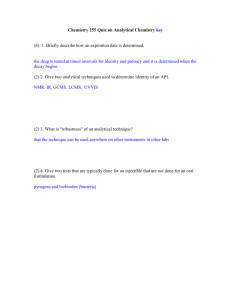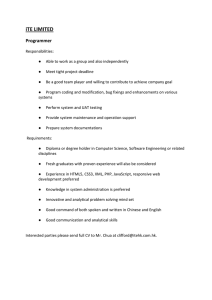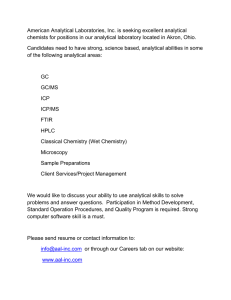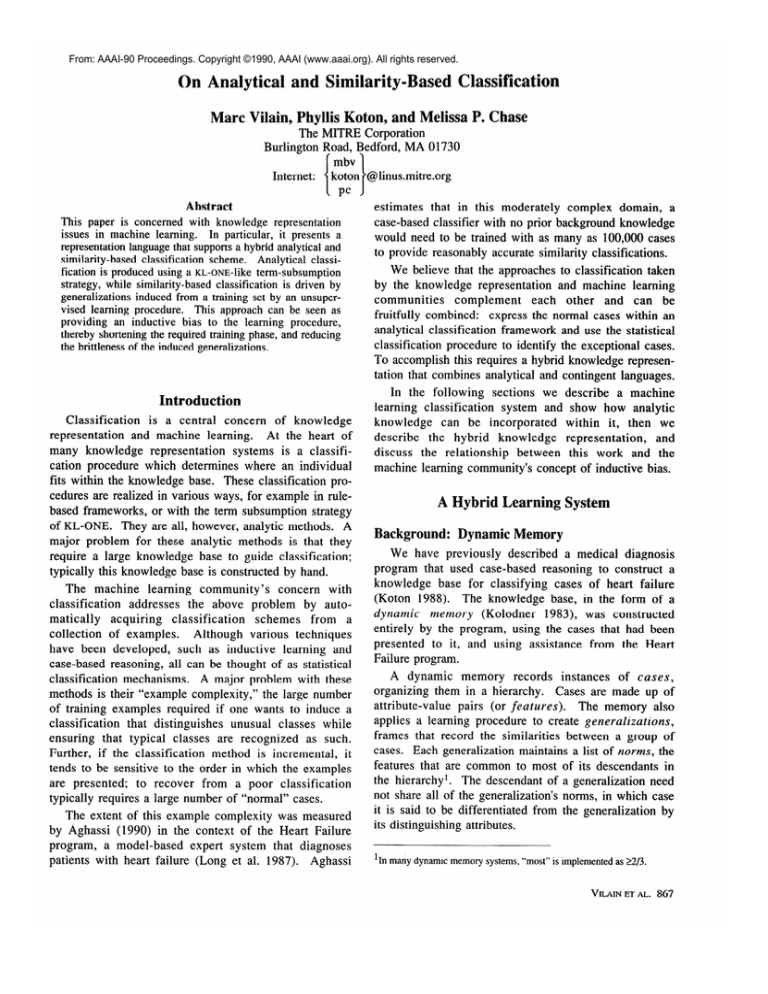
From: AAAI-90 Proceedings. Copyright ©1990, AAAI (www.aaai.org). All rights reserved.
On Analytical
and Similarity-Based
Classification
Marc Vilain, Phyllis Koton, and Melissa P. Chase
The MITRE Corporation
Burlington Road, Bedford, MA 01730
Internet:
Abstract
This paper is concerned
with knowledge
representation
issues in machine learning.
In particular, it presents a
representation language that supports a hybrid analytical and
similarity-based
classification
scheme.
Analytical classification is produced using a KL-ONE-like term-subsumption
strategy, while similarity-based
classification
is driven by
generalizations
induced from a training set by an unsupervised learning procedure.
This approach can be seen as
providing
an inductive
bias to the learning procedure,
thereby shortening the required training phase, and reducing
the brittleness of the induced generalizations.
Introduction
Classification
is a central
concern
of knowledge
representation
and machine learning.
At the heart of
many knowledge
representation
systems is a classification procedure which determines
where an individual
fits within the knowledge base. These classification
procedures are realized in various ways, for example in rulebased frameworks, or with the term subsumption
strategy
of KL-ONE.
They are all, however, analytic methods. A
major problem for these analytic methods is that they
require a large knowledge
base to guide classification;
typically this knowledge base is constructed by hand.
The machine
learning
community’s
concern
with
classification
addresses
the above problem
by automatically
acquiring
classification
schemes
from a
collection
of examples.
Although
various techniques
have been developed,
such as inductive
learning
and
case-based reasoning, all can be thought of as statistical
classification
mechanisms.
A major problem with these
methods is their “example complexity,” the large number
of training examples required if one wants to induce a
classification
that distinguishes
unusual
classes while
ensuring
that typical classes are recognized
as such.
Further, if the classification
method is incremental,
it
tends to be sensitive to the order in which the examples
are presented;
to recover from a poor classification
typically requires a large number of “normal” cases.
The extent of this example complexity was measured
by Aghassi (1990) in the context of the Heart Failure
program, a model-based
expert system that diagnoses
patients with heart failure (Long et al. 1987). Aghassi
estimates
that in this moderately
complex domain,
a
case-based classifier with no prior background knowledge
would need to be trained with as many as 100,000 cases
to provide reasonably accurate similarity classifications.
We believe that the approaches to classification
taken
by the knowledge
representation
and machine learning
communities
complement
each other and can be
fruitfully combined:
express the normal cases within an
analytical classification
framework and use the statistical
classification
procedure to identify the exceptional cases.
To accomplish this requires a hybrid knowledge representation that combines analytical and contingent languages.
In the following
sections
we describe
a machine
learning
classification
system and show how analytic
knowledge
can be incorporated
within
it, then we
describe
the hybrid
knowledge
representation,
and
discuss
the relationship
between
this work and the
machine learning community’s concept of inductive bias.
A Hybrid Learning System
Background:
Dynamic Memory
We have previously
described
a medical diagnosis
program that used case-based
reasoning to construct a
knowledge
base for classifying
cases of heart failure
(Koton 1988).
The knowledge
base, in the form of a
dynamic
memory
(Kolodner
1983), was constructed
entirely by the program, using the cases that had been
presented
to it, and using assistance
from the Heart
Failure program.
A dynamic
memory
records
instances
of cases,
organizing
them in a hierarchy.
Cases are made up of
attribute-value
pairs (or features).
The memory also
applies a learning procedure to create generalizations,
frames that record the similarities
between a group of
cases. Each generalization
maintains a list of norms, the
features that are common to most of its descendants
in
the hierarchy’.
The descendant of a generalization
need
not share all of the generalization’s
norms, in which case
it is said to be differentiated
from the generalization
by
its distinguishing
attributes.
‘In many dynamic memory systems, “most” is implemented
as 22/3.
VILAINETAL. 867
DISEASE-G2084
CASES:
3
23
NORMS
cardiomegaly(x) = LV
s2(x) = single
characteristic-murmur(x)
= AS
pulse(x) = slow-rise
apex-impulse(x) = sustained
chest-pain(x) = anginal
dyspnea(x) = on-exertion
Figure 1: A generalization
frame.
However, since the memory construction
was guided
statistically,
many “typical” cases of aortic stenosis had
to be presented so that unusual cases would not produce
an inaccurate
classification
scheme.
As suggested
above, this requirement
could have been reduced by first
defining some “normal” classifications
analytically.
analytical and contingent knowledge
To allow for analytical knowledge, we have extended
the dynamic
memory representation
with an analytic
term-subsumption
language in the style of KL-ONE.
This
language is used to define salient categories of a domain
for medical
diagnosis,
these consist of important
combination
of symptoms indicating the likelihood of a
disease.
The statistical associations induced by the casebased learning procedure
are then used to extend the
analytic framework
with contingent
knowledge,
further
refinements
of the framework,
and exceptions2.
The
representational
challenge is in meaningfully
combining
the first-order analytical definitions
with the contingent
knowledge, which is neither analytical nor first-order.
As an example of this hybrid representation,
consider
the representation
fragment
shown in Figure 2. This
fragment contains two preconstructed
categories, Zikelycardiac-disease,
and likely-valve-disease.
For the first,
2Much like a medical student at the beginning of the third year, whose
book knowledge becomes extended by clinical experience.
868
MACHINE LEARNING
I
DEFN
h(x) disease(x) A syncope(x) = on-exertion
A chest-pain(x) = angina1
As a result of seeing many instances of patients with
similar sets of symptoms,
our program created generalization categories that associated certain symptoms with
other symptoms.
For example, the symptom syncope on
exertion
identifies a disease category containing
23 of
the 45 cases presented
to the program.
Patients who
exhibited syncope on exertion also had other features in
common, for example, chest pain, a heart murmur, and
an enlarged heart (Figure 1). Diagnosing
these patients
using the Heart Failure program revealed that 16 of them
had the disease aortic stenosis.
What our program had
done, in effect, was to create a category describing the
common symptoms of aortic stenosis, without having any
previous knowledge of this disease.
Representing
I
LIKELY-CARDIAC-DISEASE
NORMS
age(x) = 60-or-greater
sex(x) = male
cardiac-catheterization(x)
= single-or-multivessel-disease
diagnosis(x) = cardiovascular-disease
LIKELY-VALVE-DISEASE
DEFN
h(x) likely-cardiac-disease(x)
A characteristic-murmur(x)
= systolic-ejection
NORMS
ekg(x) = LVH
xray(x) = cardiomegaly
cardiac-catheterization(x)
= normal
diagnosis(x) = aortic-stenosis
Figure 2: A representation
fragment.
textbook knowledge tells us that symptoms of syncope on
exertion and chest pain are indicators of the likelihood of
heart disease.
This is captured in the representation
by
giving the category likely-cardiac-disease
the definition3
kc (syncope(x) = on-exertion)A(chest-pain(x)
= anginal).
In addition, the representation
of this category indicates a
number of norms, contingent properties which tend to cooccur or co-vary with syncope and chest pain (though not
necessarily
in the strict statistical
sense), for example,
age > 60, sex = male, and single- or multi-vessel
disease
on cardiac catheterization.
In fact, the probability
of
syncope and chest pain being caused by cardiovascular
disease is sufficiently high that the likely-cardiac-disease
category includes that diagnosis as a norm.
Norms are
interpreted as defaults, so this knowledge structure does
not imply that all patients with syncope and chest pain
are males over 60 with cardiovascular
disease, but that
these symptoms are found primarily in older males and
are caused by cardiovascular
disease.
The default nature of norms is evidenced by the category likely-valve-disease,
which is analytically differentiated from the category of patients with syncope and chest
pain by the presence of the symptom systolic
ejection
murmur.
Here, the default diagnosis of cardiovascular
3Properly
speaking, this definition actually denotes something
medical-case-whose-symptoms-are-likely-indicators-of-cardiac-disease.
We are using shorter names for their obvious legibility benefits!
like
disease is overridden
by the default diagnosis of aortic
stenosis.
Also, we find a different set of symptoms that
covary
with syncope,
chest pain, and murmur,
for
example, left ventricular
hypertrophy
on EKG and an
enlarged heart on x-ray.
Incorporating
specific cases
The norms in the preceding examples could have been
defined by the user as part of the knowledge acquisition
More interestingly,
they could equally have
process.
been induced by the dynamic memory learning procedure
from a set of training cases, as with the generalization
in
Figure 1. The learning procedure can thus be seen as a
mechanism
for acquiring
the contingent
knowledge
encoded in the representation.
Additionally,
by indexing
training cases into the analytical hierarchy, the learning
procedure
extends
the hierarchy
with (contingent)
refinements and exceptions.
The learning procedure indexes training cases in the
hierarchy by matching them to existing categories.
For
example, suppose the system is presented with a case x
which is described by the features syncope=on-exertion,
chest-pain=anginal,
murmur=systolic-ejection,
sex=male,
and age=30-or-less.
The values for attributes syncope,
chest-pain,
and murmur
identifies
this case as an
exemplar of the category likely-valve-disease.
However,
the value 30-or-less
for attribute age distinguishes
this
case from the category likely-valve-disease
because the
majority of cases in that category have value 60-or-more
for age (a norm inherited from likely-cardiac-disease).
The new case is thus inserted into the hierarchy directly
underneath the likely-valve-disease
frame, differentiating
it by providing a different value to the age attribute.
When multiple cases are indexed to the same place in
the hierarchy,
the learning
procedure
creates
a
generalization
capturing their common features as a set
of norms.
The cases are then indexed below the new
generalization,
differentiated
from it by the features they
fail to share. It is this process which inductively extends
the analytical
framework
with contingent
knowledge
derived from the training cases.
The Analytical
Language
Our analytical
language
is an extremely
simple
definitional
frame language, which is based on the term
subsumption
strategy of KL-ONE.
The language provides
three frame-forming
operators which are used to form
complex
frame terms:
definitions
are performed
by
naming the resulting terms.
Our first operator, AND,
We interpret the expression
ax
CplW
A q2c-d
simply
conjoins
frame terms.
(AND qp1 432 . . . cpn) as
A *.* A cp,w
The second operator, ATTR, restricts a frame to take a
We thus intepret the
certain value for an attribute.
expression
(ATTR a p) as
ax ~<-a
We will adopt a restriction
common in the machine
learning classification
literature,
and treat attributes as
functions.
Therefore, ATTR expressions such as the one
above can additionally be read as il x a(x) = p
it is often necessary
to form the
Additionally,
disjunction
of attribute selections, for which we use our
third frame-forming
operator, ATTR*.
We thus interpret
the expression (ATTR* al p1 ... a, fin) as
~-d~l(x)=pl)v
**- w%l(x)=p*)
Analytical
definition
are created
by naming
a
complex term.
In the heart disease domain, we might
define likely cases of valve disease as follows
LIKELY-VALVE-DISEASE
=
(AND
LIKELY-CARDIAC-DISEASE
(A TTR CHARACTERISTIC-MURMUR
SYSTOLIC-EJECTION))
As usual, such definitions as these are interpretable
universally quantified biconditionals,
in this case
as
vx LIKELY-VALVE-DISEASE
(x) H
LIKELY-CARDIAC-DISEASE(x)
A
CHARACTERISTIC-MURMUR
(x) =
SYSTOLIC-EJECTION
As with other KL-ONE derivatives,
classification
in
our
analytical
language
is performed
by term
subsumption.
That is, frames are organized
in a
hierarchy, with frame ql placed below frame 4.~2just in
case the meaning of rpI is entailed by that of (~2, i.e., just
in case the sentence ‘V’Xqpl(x) * 92(x) is valid. We then
say that qI is subsumed by ~2. In effect, qI is (nontrivially)
subsumed
by (~2 just in case ql satisfies the
definition of 45 and additionally
possesses one or more
attribute assignments
not valid for (~2. Classifying
a
frame cp simply consists of finding those frames in the
hierarchy
that immediately
subsume
cp. Despite the
extreme simplicity of this language, frame classification
in general can be shown to be NP-complete,
by a
straightforward reduction from 3-SAT.
However, for the knowledge bases of interest to hybrid
classification,
we will be concerned only with definitions
in the normal form
~1 = (AND
~2 (ATTR
(ATTR*
al
PI)
. . . (ATTR
ai pi)
aj Pj . . . % Pn>>
where ~1 and “/2 are categories,
the a terms are attributes, and the p terms are values. This normal form is of
interest as it characterizes the generalizations
induced by
the learning
procedure.
As we shall see below, for
knowledge bases of such definitions,
analytical classification is no longer NP-complete, but tractable.
VILAIN ET AL. 869
The Contingent
0(e) = disease(e) A syncope(e) = on-exertion
A chest-pain(e) = anginal
A characteristic-murmur(e)
Language
The term hierarchy defined in the analytical language
provides a framework within which to express the contingent associations
derived by the case-based
learning
procedure.
In essence, these associations
describe the
covariances of attribute-value
assignments that hold for a
particular
generalization.
These covarying
feature
assignments
can be interpreted
as mutually
providing
evidence for each other: if any single one of them holds,
the others can be assumed to do so as well, at least in
the context of the same generalization.
Consider, for example, two generalizations
~1 and m,
in which ‘y2 differs from y1 by assigning
to some
attributes aI, a2 . . . . an the values /?I, p2, . . . . pn. If we
know that, for some entity e, ~1 (e) A al(e) = PI, then if
we additionally
choose to believe
Yz(e), we would
assume a2(e) = p2 , . ..,an(e) = /In by default, as these
feature assignments covary with al(e) = PI. The process
of making assumptions
in this way captures the essence
of similarity-based
classification.
Knowing
that e is
similar in some way to instances of m allows us to infer
that e might possibly be an instance of ~2, and thereby
possess other features common to the class.
In earlier papers ((Koton & Chase 1989), (Koton,
Chase, & Vilain 1990)), we applied Reiter’s default logic
to model similarity-based
classification
in case memory.
This treatment can be extended to encompass analytical
classification
as well.
We do so by interpreting
the
generalizations
formed
by the case classification
procedure with the following two axiom schemata, one
analytical
and the other contingent.
Let ~1 and ~2 be
generalizations
that, as above, differ in 71’s assigning
values PI . . . & to attributes al . . . an. Then
jp
Y2W
(AND
~1 (ATTR*
: wW=P1
al p1 . . . a,
,.--, Y2W
a1W=P1
: %W=PIl
pn))
(link)
(norm)
%W=P*
The link schema creates an analytical definition for m,
requiring
it to differ from y1 by at least one of the
assignments
to attributes
al . . . a,.
The norm schema
captures the covariance of the ai by introducing a normal
default rule (Reiter 1980) for each assignment of some pi
to the corresponding
ai.
It is easy to see how these axiom schemata enable
similarity-based
classification.
For example, say that for
some particular
71, al, PI, etc, an entity e is described
by the theory e(e) = yl(e) A (al(e)
= pl) A . . . . Then
m(e) is true from the biconditional
interpretation
of the
link schema, and the remaining
ai
= pi become true
by default, so long as they are consistent with e(e).
The contingent language of our representation
scheme
is just the language of normal default rules that have the
870 MACHINE LEARNING
= systolic-ejection
DISEASE
(e) = cardiovascular-disease
LIKELY-CARDIAC-DISEASE
DEFN
h(x) disease(x) A syncope(x) = on-exertion
A chest-pain(x)
= anginal
NORMS
likely-cardiac-disease(x)
: diagnosis(x)
diagnosis(x)
= cardiovascular-disease
= cardiovascular-disease
...
f$(e)=
$(e)
h ...
diagnosis(e)
A
= aortic-stenosis
LIKELY-VALVE-DISEASE
DEFN
h(x) likely-cardiac-disease(x)
A characteristic-murmur(x)
= systolic-ejection
NORMS
likely-valve-disease(x)
diagnosis(x)
: diagnosis(x)
= aortic-stenosis
= aortic-stenosis
...
Figure 3: A memory
fragment
showing
cancellation.
form of the norm schema. However, there is more to the
representation
of contingent
reasoning than the specification of those normal defaults that express the case
memory covariances
induced by the learning procedure.
The hierarchies
induced
by the learning
procedure
typically require the cancellation
of feature assignments
on the basis of specificity
(as with the assignments
to
diagnosis
in Figure 3). With a default encoding
of
property inheritance,
this leads to case memory theories
having multiple extensions,
only the most specific of
which is legitimate
(e.g., 82 in Figure 3). We must
therefore indicate how to interpret this non-monotonic
aspect of property inheritance.
Understanding
Cancellation
In default logic, the traditional
approach
towards
handling
cancellation
in non-monotonic
inheritance
is
through semi-normal
defaults
((Etherington
& Reiter
1983), (Reiter & Criscuolo
1983)).
This solution
is
unappealing
for several reasons.
For one, it potentially
requires encoding the topology of the entire inheritance
network into each norm default.
The global reasoning
task this presupposes is a poor model of inheritance with
cancellation,
which is typically
understood
as a local
B(nixon) = . . . faith(nixon)
= quaker
A
party(nixon)
= g.0.p.
PERSON
eI(nixon) = e(nixon)
A
8 2(nixon) = B(nixon)
pacifism(nixon)=dove
A
pacifism(nixon)=hawk
72
DEFN
y1
DEFN
I,(x) person(x) A
(faith(x) = quacker v pacifism(x) = dove)
X(x) person(x) A
(party(x) = g.o.p. v pacifism(x) = hawk)
NORMS
NORMS
3 (x) : pacifism(x) = dove
yl(x) : pacifism(x) = hawk
pacifism(x)
pacifism(x)
= hawk
Figure 4: The infamous
Additionally,
with a semi-normal
reasoning
process.
encoding of cancellation,
the default characterizations
of
memory structures induced by the learning procedure are
not necessarily
ordered in Etherington’s
sense (Koton,
Chase, & Vilain 1990). This means that they can not be
guaranteed an extension by existing default proof theories
(Etherington
1988).
As case memory theories actually
always do have extensions,
this makes a semi-normal
encoding of cancellation even less appropriate.
We have chosen
the alternative
of separating
inheritance
from cancellation,
expressing
property
inheritance
with normal defaults (as above), and relying
on an external criterion to determine
cancellation.
In
(Koton, Chase, & Vilain 1990), we describe one such
criterion based on Poole’s notion of theory preference
(Poole 1985). We can easily extend this criterion (and
in fact simplify it) to encompass our analytical terms
Say e(e) is some theory of some entity e, and say
81 (e) and 02(e) are extensions
of e(e) that assign
different values p1 and p2 to an attribute a. Note that
these values must have been respectively
assigned by
some default rules 61 and & such that
We then say that 81 < a 82 just in case yl (the precondition of 61) subsumes y2 (the precondition
of 82).
Subsumption
in this case is simply the relationship
of
meaning-entailment
defined over terms in the analytical
language which is used to define the preconditions
of
defaults.
In Figure 3, for example,
81 <diagnosis 02
because the precondition
of the default that assigned
cardiovascular-disease
to diagnosis in 81 is subsumed by
that of the default that assigned it aortic-stenosis
in 02.
= dove
*‘*
Nixon diamond.
the prefered extensions are those which are maximal in
<a for all attributes a. In Figure 3 for example, 02 is
the assignment
of
prefered
over 81, thus cancelling
cardiovascular-disease
to diagnosis which holds in 81. In
contrast, the 81 and 02 of Figure 4 are both maximal,
since the defaults that lead to their incompatibility
on
pacifism
have incomparable
preconditions
(neither one
subsumes the other).
In essence,
our preference
criterion
selects those
extensions of a theory in which attribute values are only
assumed
using the most specific
applicable
default.
What’s especially
appealing about this approach is that
the determination
of specificity is entirely cast in terms
of the analytical
language
which naturally
supports
specificity through subsumption.
Integrated Classification
The knowledge representation
task begins by using the
analytical
language
to define initial categories
which
will later be extended by the learning algorithm4.
The
representation
hierarchy is then built by classifying these
definitions
with respect to the subsumption
relation;
as
noted above, this is an NP-complete
process.
This NPcompleteness
must be taken in perspective,
however.
For the purpose
of identifying
salient
diagnostic
categories,
one can limit definitions
to conjunctions
of
feature assignments
created by only using AND and
In this case, classification
becomes
ATTR expressions.
tractable with an algorithm such as that of (Schmolze &
Lipkis 1983).
To enforce cancellation on some feature a, we simply
select as our prefered extensions
those maximal in <a.
Next, the hierarchy is extended with the case memory
This is accomplished
by classifying
learning procedure.
training cases using both analytical
and similarity
criteria.
Simultaneously,
running statistics are maintained
of the relative frequency of attribute-value
assignments:
To extend
this minimality
criterion
into a theorypreference criterion, say e(e) is a theory of some entity
From among these 0i,
e, with extensions
@l(e) . . . e,(e).
4These are similar to the T Box definitions of (Brachman,
Fikes, &
Levesque 1983) which are completed by (user-declared) A Box axioms.
VILAIN ET AL. 871
these are used to establish
norms, and reorganize
the
hierarchy should it prove to reflect a skewed presentation
order. We will say little about the statistical aspects of
the learning procedure,
focussing
on the classification
process instead (see (Kolodner 1983) for details).
The classification algorithm
The hierarchy
is implemented
as a graph in which
categories are connected by two kinds of attribute-value
links. Necessary links correspond to conjoined attributevalue assignments,
such as those in the analytical
definitions.
Contingent links correspond to disjuncts from
A T TR * expressions,
and are used to implement
similarity-based
classification.
The key to the operation
of the algorithm
is that all of the contingent
links
connecting two nodes are interpreted as part of the same
disjunction.
This effectively
restricts
the analytical
definitions of categories to be in the normal form.
~1 = (AND
j-9
(ATTR
al
PI)
. . . (ATTR
(ATTR*
aj Pj . . . an Pn>)
ai pi)
The ATTR expressions
in the normal form correspond
to feature conjunctions
specified in the category defiexpression
nitions predefined by the user. The ATTRR*
encodes the feature assignments
by which the learning
procedure determined
the category to be differentiated
from its parent in the hierarchy.
Turning to the details of the classification
algorithm,
to classify a case x, with initial description 8:
(1) Let known be a list of properties known to be true
of x, and let defaults
be
conjectured to be true of x.
are simply those which hold
ones are added by the norm
a list of properties
The known properties
in 8, the conjectured
defaults.
(2) Starting with the root of the hierarchy, proceed
down the hierarchy
by following
links which
match propositions in known.
(Analytical
classification)
If nodes ~1 and y2
(3)
are linked by any necessary
links, then to
proceed from “/1 to ~2 all such links must be
matched by properties in known .
(4)
(Similarity
classification)
Separately, if nodes
~1 and ~2 are only linked by contingent
links,
then to proceed from ~1 to y2 at least one such
link must be matched by properties in known.
several paths could be followed from
(5) Potentially,
a given node y, each leading
to a different
classification.
If so, the algorithm follows each
path independently.
(6) For each norm at each node, if the norms does
not contradict some property in known, it is added
to defaults, overriding any properties in defaults
which it contradicts.
872 MACHINE LEARNING
(7) The algorithm
terminates
(along each independent path) when the leaves of the hierarchy are
reached, or no links can be followed from a node.
The algorithm returns, ~1 . . . Xn, the nodes at the
end of each path, along with the values of known
and defaults.
It can be shown that the nodes returned by this algorithm define the maximal extensions of the initial theory
0(x). The theories are simply defined by the properties
which hold at these nodes (the union of known
and
defaults in the algorithm).
It is also easy to show that the
algorithm computes these extensions in polynomial time.
For details see (Koton, Chase, & Vilain 1990).
In order to actually add x to the hierarchy, x must
additionally be indexed to each Xi in ~1 . . . Xn, If Xi is a
generalization,
x is inserted below Xi and linked to it by
a contingent link for each property of Xi which x does not
share. If Xi is another case, a generalization
x’ is first
created, and given as norms those properties shared by Xi
and x. These two cases are then indexed below x’ with a
contingent link for each property they don’t share with x’.
Indexing
x below the Xi effectively
joins the separate
paths taken by the algorithm.
It is easy to show that indexing a case to the hierarchy
with this strategy effectively
provides the case with a
normal form definition.
It is also possible to show that
the structure of the hierarchy encodes the subsumption
relations between the definitions
of its category node$.
This leads directly to the tractability
of computing
the
subsumption
of the normal form definitions
induced by
the learning procedure.
A classification example
To illustrate this classification
process, say we had
created a hierarchy by predefining
the categories likelyheart-disease
and likely-valve-disease.
The definitions of
these categories
are reproduced
in Figure 5 (below),
along with some norms that might have been assigned at
some point to these categories by the learning procedure
(assume for now that disease-g0017
has not been created
yet). Say we are now shown a case e of youthful aortic
stenosis, a fictitious but illustratively
useful disease, with
e characterized by the following feature assignments.
syncope(e) = on-exertion
chest-pain(e) = angina1
characteristic-murmur(e)
= on-ejection
age(e) = 30-or-under
diagnosis(e) = youthful-aortic-stenosis
51n brief, this follows from the fact that the same attribute-value pair can
never appear twice on a given path, thus imposing an ordering on the
disjunctive components of definitions.
From the latter, the contingent link for age can
disease.
be followed down to disease-g001 7, as f also assigns 30or-less to the age feature. This classifies f by similarity
as an instance of disease-g001
7; f then inherits this
category’s
consistent
norms by default,
including
an
assignment of youthful-aortic-stenosis
to diagnosis.
LIKELY-CARDIAC-DISEASE
DEFJ (= necessary links)
A.(x) disease(x) A syncope(x) = on-exertion
A chest-pain(x) = anginal
NORMS (= contingent links)
age(x) = 60-or-greater
diagnosis(x) = cardiovascular-disease
I
Relation to Inductive Bias
LIKELY-VALVE-DISEASE
DEFN (necessary
links)
h(x) likely-cardiac-disease(x)
A characteristic-murmur(x)
= systolic-ejection
NORMS (contingent links)
age(x) = 60-or-greater (inherited)
diagnosis(x) = aortic-stenosis
DISEASE-GO017
“Youthful valve disease”
1
NORMS (contingent links)
age(x) = 30-or-under
diagnosis(x) = youthful-aortic-stenosis
...
Figure
5: An induced category
(DISEASE-GO017).
During classification,
say e enters the hierarchy at the
level of disease.
It is then compared to the necessary
links between disease and its descendant likely-cardiacdisease.
These necessary links are simply the two explicit feature assignments
in the latter category’s definition:
syncope(x)=on-exertion
and chest-pain(x)=anginal.
Since
e has feature assignments to syncope and chest-pain that
match these necessary links, it traverses them and is thus
analytically
classified as an instance of likely-cardiacdisease.
Similarly,
e matches
the necessary
links
between likely-cardiac-disease
and likely-valve-disease,
allowing it to be analytically
classified as an instance of
the latter category.
The case is then entered into the
hierarchy by creating node disease-g00I 7 and giving it as
norms the feature assignments
to age and diagnosis that
differentiate e from likely-valve-disease.
These norms are in turn interpreted as contingent links
between likely-valve-disease
and disease-g001 7; these
can be exploited
to perform similarity-based
classification. For example, say we are now shown a new case f
which shares e’s feature assignments
for syncope, chest
pain, characteristic-murmur,
and age, but has no assignment to diagnosis.
Like e, f will be classified
analytically below likely-cardiac-disease
and likely-valve-
The enterprise
we have described
above can be
related to a concern
of researchers
in the machine
learning
community,
inductive
bias. The task of the
statistical classification
methods described earlier is to
induce a classification
upon being presented
with a
sequence of examples.
That is, the learning program
partitions
the examples
into a set of (not necessarily
disjoint) classes.
When the examples are labeled with
their class (often just a binary labeling),
the task is
called
“learning
from
examples”
or “supervised
learning,”
and the learning program produces an intensional description of the classes. When the examples are
not labeled, and the learning program must induce the
classes as well as the intensional
descriptions
of the
classes, the task is called “concept formation”
or “unsupervised learning.” (Gennari, Langley, & Fisher 1989)
Both learning
tasks may be viewed
as a search
through a space of hypotheses, in which each hypothesis
represents
a partition
of the examples.
To keep the
learning
task tractable,
machine
learning
researchers
early recognized
the need to incorporate
into their
systems an inductive bias, namely, some mechanism for
controlling the search of the hypothesis space (Russell &
Grosof 1990). This bias controls the number of examples
needed to induce a classification.
There are two major types of bias (Utgoff 1986): (1)
restricting
the hypothesis
space, and (2) ordering
the
hypotheses.
The first bias is usually imposed by limiting
the concept description
language;
the second is often
achieved
through
some general
preference,
such as,
prefering a simpler to a more complex description. More
recently,
researchers
have proposed
a more general
framework for inductive bias, namely, viewing it as prior
knowledge that becomes part of the context within which
the learning system operates (Russell & Grosof 1990). In
particular,
explanation-based
learning,
an analytic
learning technique, can be viewed as using “background
knowledge”
as a type of bias;
the generalizations
produced through explanation-based
learning
are biased
towards
those that can explained
in terms of this
background knowledge (Ellman 1989).
Much of the research into inductive bias, particularly
that which makes use of analytic learning techniques,
has focused upon (supervised)
learning from examples.
VILAIN ET AL. 873
Our hybrid learning system, however,-can
be viewed as
employing
an analytical
classification
method as an
inductive
bias for an unsupervised
concept formation
task.
In our system, the hypothesis space is implicitly
represented;
the current memory structure represents the
current hypothesis
regarding
the classification
scheme.
The prior knowledge encoded in the memory structure is
a declarative bias. When a new instance is presented to
be incorporated
into the memory
structure
(perhaps
causing the memory to be restructured),
the classification
algorithm can be viewed as conducting
a search of the
hypothesis space, using the analytic knowledge as a bias
focusing the search.
Conclusion
In this paper we have presented
a mechanism
for
combining
the machine
learning
and knowledge
representation
approaches to classification,
and described
a hybrid
knowledge
representation
appropriate
for
handling analytic and contingent
knowledge.
Our goal
has been to use analytic knowledge as an inductive bias
to focus the statistical learning procedure.
One obvious extension
is to use prior contingent
knowledge along with analytic knowledge to set up the
initial memory.
The analytic
language
was used to
define the essential
links of the hierarchical
classification; we could also use the contingent
language to
define some of the well-known,
textbook
covarying
features in advance.
For example, a patient with general
symptoms of heart disease who happens to be thirty or
younger is almost certainly suffering of valve disease,
despite the fact that the age norm for valve disease is
greater than sixty. We expect that allowing for such nonanalytic associations
as these would further reduce the
statistical
learning
method’s sensitivity
to exceptional
cases and to poor presentation order.
We should note that our work to date has focussed
primarily on theoretical considerations
of representation
and tractability.
We intend to further validate our results
by carrying out experiments
to compare the performance
of the learning method with and without the use of prior
Finally, we would like to impleanalytic knowledge.
ment our work in other diagnostic domains and explore
the feasibility of this approach to other application areas.
References
Aghassi, D. 1990. Evaluating Case-based Reasoning for
Heart Failure Diagnosis.
SM thesis, Lab for Computer
Science, Massachusetts
Institute of Technology.
Brachman, R.J., Fikes, R.E., and Levesque, H.J. 1983.
Krypton:
A Functional
Approach
to Knowledge
Representation.
Computer, 16(10):67-73.
874 MACHINE LEARNING
Ellman,
T.
1989.
Explanation-Based
Learning:
A
Survey of Programs and Perspectives.
Computing
Surveys, 2 1: 163-22 1.
Etherington,
D.W.
1988. Reasoning
with Incomplete
Information . Research Notes in Artificial Intelligence.
Morgan Kaufmann Publishers, Inc., San Mateo, CA.
Etherington,
D.W., and Reiter, R. 1983. On Inheritance
Hierarchies
with Exceptions.
In Proceedings
of the
Third National Conference
on Artificial Intelligence,
Washington, DC.
Gennari, J.H., Langley, P., and Fisher, D. 1989. Models
of Incremental
Concept
Formation.
Artificial
Intelligence, 40: 1 l-61.
Kolodner,
J.L.
1983.
Maintaining
Organization
in a
Dynamic
Long-Term
Memory.
Cognitive
Science,
7:243-280.
Koton, P.A. 1988. Reasoning about Evidence in Causal
Explanations.
In Proceedings of the Seventh National
Conference on Artificial Intelligence,
St. Paul, MN.
Koton,
P.A., and Chase, M.P.
1989.
Knowledge
Representation
in a Case-Based
Reasoning
System:
Defaults and Exceptions.
In Proceedings of the First
International
Conference
on Principles of Knowledge
Representation
and Reasoning,
Toronto,
Ontario,
Canada.
Koton, P.A., Chase, M-P., and Vilain,
M.B.
1990.
Knowledge
Representation
in a Case-Based
Reasoning
System:
An Extended
Version.
In
preparation.
Long, W.J., Naimi, S., Criscitiello,
M.G., and Jayes, R.
1987. The Development
and Use of a Causal Model
for Reasoning about Heart Failure.
In Proceedings of
the 1 lth Symposium
on Computer
Applications
in
Medical Care,
Poole, D.
1985.
On the Comparison
of Theories:
Preferring
the Most Specific
Explanation.
In
Proceedings
of the Ninth
International
Joint
Conference
on Artificial
Intelligence,
Los Angeles,
CA.
Reiter, R.
1980.
A Logic for Default Reasoning.
Artificial Intelligence, 13:8 1- 132.
Reiter,
R.,
and
Criscuolo,
G.
1983.
Some
Representational
Issues
in Default
Reasoning.
Computers and Mathematics
with Applications,
9: 1527.
Russell, S.J., and Grosof, B.N. 1990. Declarative Bias:
An Overview.
In D. Paul Benjamin, ed. Change of
Representation
and Inductive
Bias.
Kluwer
Academic Publishers, Boston, Dordrecht, London.
Schmolze, J.G., and Lipkis, T.A. 1983. Classification
in
the KL-ONE Knowledge
Representation
System.
In
Proceedings
of the Eighth
International
Joint
Conference on Artificial Intelligence,
Karlsruhe, FRG.
Utgoff, P. 1986. Machine Learning of Inductive Bias.
Kluwer
Academic
Publishers,
Boston,
Dordrecht,
Lancaster.

